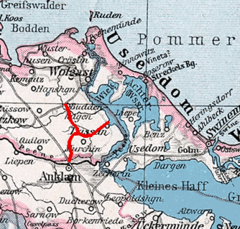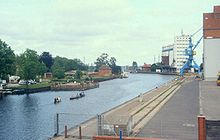Anklam-Lassaner small train
| Anklam-Lassan / Buddenhagen | |||||||||||||||||||||||||||||||||||||||||||||||||||||||||||||||||||||||||||||||||||||||||||||||||||||||||
|---|---|---|---|---|---|---|---|---|---|---|---|---|---|---|---|---|---|---|---|---|---|---|---|---|---|---|---|---|---|---|---|---|---|---|---|---|---|---|---|---|---|---|---|---|---|---|---|---|---|---|---|---|---|---|---|---|---|---|---|---|---|---|---|---|---|---|---|---|---|---|---|---|---|---|---|---|---|---|---|---|---|---|---|---|---|---|---|---|---|---|---|---|---|---|---|---|---|---|---|---|---|---|---|---|---|
| Course book range : | 112 c | ||||||||||||||||||||||||||||||||||||||||||||||||||||||||||||||||||||||||||||||||||||||||||||||||||||||||
| Route length: | 32.62 km | ||||||||||||||||||||||||||||||||||||||||||||||||||||||||||||||||||||||||||||||||||||||||||||||||||||||||
| Gauge : | 600 mm ( narrow gauge ) | ||||||||||||||||||||||||||||||||||||||||||||||||||||||||||||||||||||||||||||||||||||||||||||||||||||||||
| Minimum radius : | 27 m | ||||||||||||||||||||||||||||||||||||||||||||||||||||||||||||||||||||||||||||||||||||||||||||||||||||||||
|
|||||||||||||||||||||||||||||||||||||||||||||||||||||||||||||||||||||||||||||||||||||||||||||||||||||||||
The Anklam-Lassaner Kleinbahn (ALKB) was founded on March 30, 1895 as a stock corporation with the Kleinbahngesellschaft Anklam − Lassan company in Greifswald. The Prussian state , the province of Pomerania , the district of Greifswald and the cities of Greifswald and Lassan - in the first few years also the company Lenz & Co. GmbH - were involved. On January 1, 1940, it went on in the Greifswalder Bahnen of the Pomeranian State Railways .
history
The Anklam-Lassaner-Kleinbahn (ALKB) opened up the area around the city of Anklam in Western Pomerania north of the Peene and the Lassaner Winkel with two small railroad lines . The starting point was the town of Anklam, where there was a connection to the Stralsund – Pasewalk state railway and to the Mecklenburg-Pomerania narrow-gauge railway network . Most of the routes were opened on April 17, 1896.
In the summer of 1914, two to three pairs of trains ran daily between Anklam and Lassan, with a journey time of almost one and a half hours. An additional pair of trains was inserted on market days. There was only one train from Anklam to Buddenhagen and back on Wednesdays, Sundays and public holidays in summer. The line fell far short of expectations and was only operated as far as Rubkow from 1927. Two years later, the Wahlendow – Pamitz section was dismantled.
In 1910 the management of Lenz & Co was transferred to the small railway department of the Pomeranian Provincial Association in Stettin. After its dissolution, the Association of Western Pomerania Small Railways took its place in 1920 and the Pomeranian State Railway Directorate in 1937/1938. When the Pomeranian State Railways were established as a public corporation on January 1, 1940, the Kleinbahn Anklam – Lassan with a route length of 16 kilometers was assigned to the Greifswalder Bahnen . In the literature (Bufe) one occasionally speaks of an "Anklamer Bahn".
The sparse passenger traffic came to a standstill more and more in the time of crisis after the First World War and was completely replaced by omnibuses in 1927.
In 1935, the GGE transported 3,621 people and 18,004 tons of goods.
In the summer of 1945, however, there was once again passenger transport by rail.
But also the freight traffic, which the railway was supposed to serve mainly, fell short of expectations, so that in the 1930s only the Anklam – Lassan route and a branch from Crenzow to Rubkow were used. The tracks that had not yet been dismantled in the 1920s were dismantled in autumn 1945 for reparation purposes.
Route network
Routing
The initially 32.62 kilometer long network had its starting point in Anklam and was initially laid east of Greifswalder Straße on the northern bank of the Peene, as the existing Anklam Peene bridge did not have enough load-bearing capacity for an additional small railway. Cumbersome reloading operations from rail to carts were therefore necessary. At the latest with the connection of the granary, the necessary railway systems could be built near the port in the urban area of Anklam. In addition, a siding to the MPSB was laid, which also enabled a connection to the state railway in Anklam.
When leaving the ALKB train station in Anklam ( Peene train station ), the Lassaner line initially led into a hairpin in Ravelinstraße, where there were also connecting tracks to the local potato flake factory. It continued in the opposite direction towards the Peene Bridge. After crossing the bascule bridge, which was also used for road traffic, the track in Greifswalder Straße continued northwards. The line crossed the state railway line (Berlin–) Angermünde – Stralsund at the same level as Greifswalder Strasse, whereby the small railway line was technically secured at this point by derailment switches and form signals. Essentially, the ALKB track also ran on the other sections of the route along existing paths and roads.
The track led north to Krenzow (10.4 km), where the branch to the branch to Buddenhagen was. The Lassaner route described an arc and continued in an easterly direction to Lassan (19.4 km) on the Peenestrom , where the port and the local furniture factory were also served at times. From Krenzow, the second line went north via Wahlendow to Buddenhagen (11.0 km) on the Züssow – Wolgast state railway . The route partly led through larger forest areas, which also secured long timber transport for the railway. Since October 5, 1899, a one kilometer long line to Pamitz has branched from Wahlendow.
In the statistics, the route length is given in 1928 as 27 kilometers and in 1939 as 21 kilometers. Most recently (1940/44) it is said that five kilometers of it were shut down.
Superstructure
The entire network of the ALKB was designed with a 600 millimeter gauge and built by Lenz & Co. GmbH. Only wooden sleepers were used (one sleeper per meter of track), on which nine meter long Vignole rails with a mass of 13.92 kilograms per meter lay. Grooved rails with a mass of 26.5 kilograms per meter were paved in the city of Anklam. Without the purchase of land, the cost of building the railway lines was 824,500 gold marks .
Sidings
Freight traffic predominated on the ALKB from the start. Numerous sidings made it possible to transport goods to and from companies and yards by rail, including the following companies:
- Anklamer potato flake factory
- Anklamer harbor warehouse
- Anklamer cell storage system (from 1935)
- Anklamer soil storage
- Anklamer sugar factory (until 1935)
- Buddenhagen timber loading
- Good Lentschow
- Gut Papendorf
- Good Zarrenthin
- Lassan fishing port
- Lassan furniture factory
In addition, there was a siding to the MPSB route network since 1899, which served as a wagon transfer between the two small railways.
ALKB vehicles
Locomotives
| ALKB locomotives | |||||
|---|---|---|---|---|---|
| Locomotive no. | design type | Manufacturer | Model | Factory no. | Remarks |
| 1q | Cn2t | Vulcan | 1895 | 1480 | |
| 2q | Cn2t | Vulcan | 1895 | 1481 | |
| 3q | Cn2t | Vulcan | 1895 | 1482 | † after 1935 |
The ALKB had three wet steam locomotives built by Vulcan ( Lenz type q ). To reduce the axle loads, these locomotives were designed with three driving axles; their service weight is given as 10.4 t. Some sources name a fourth steam locomotive (Hagans, built in 1899, factory number: 387), which is said to have been in service before passenger trains around 1910. In contrast to the 1q - 3q locomotives, this had only two driving axles. Two locomotives were taken over by the Pomeranian State Railways and were given the operating numbers 301 and 302.
Fleet
| ALKB car | ||||
|---|---|---|---|---|
| design type | Manufacturer | Construction year | number | LüP in mm |
| Pw | brat | 1895 | 1 | 6050 |
| C. | brat | 1896 | 4th | 6050 |
| Ow | Brat, Beu | 1895/98 | 70 | 4600 |
| Gw | brat | 1895 | 9 | 4600 |
| GGw | brat | 1897/ 1907 |
3 | 9100 |
| Drain | brat | ? | 1 | 3300 |
Due to the low number of passengers, the ALKB only had four passenger cars, each with space for 18 people. There was also a 6,050 millimeter long baggage cart. The railway company had a total of 82 freight cars for freight transport, 70 of which were open-type freight cars and some were also used for transporting beet . Three four-axle boxcars were suitable for transporting pieces of furniture from the Lassaner furniture factory, which had its own siding. There is evidence that vehicles have since been rented from the MPSB.
literature
- Wolfram Bäumer, Siegfried Bufe: Railways in Pomerania . Bufe-Fachbuchverlag, Egglham and Munich 1988, p. 150ff. ISBN 3-922138-34-9
- Wolf-Dietger Machel : The Anklam-Lassaner Kleinbahn. In: Contributions to Lassan's local history. 1995/96, p. 36ff.
- Werner Hormann, Wolf-Dieter Machel: Small railways in the old district of Greifswald . Kenning, 1998. ISBN 3-927587-85-0
- Joachim Braun: Change Ducherow! - Railways in Anklamer Land , Steffen Verlag 2007, pp. 144ff. ISBN 978-3-940101-13-6 .

